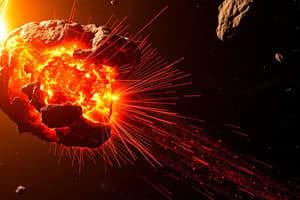Podcast
Questions and Answers
A menacing asteroid, some six miles wide, triggered Earth's last mass ______.
A menacing asteroid, some six miles wide, triggered Earth's last mass ______.
extinction
This behemoth object came from beyond the gas giant ______.
This behemoth object came from beyond the gas giant ______.
Jupiter
Today this impact zone is called the ______ Crater.
Today this impact zone is called the ______ Crater.
Chicxulub
Around 70 percent of Earth's species ______ due to the impact.
Around 70 percent of Earth's species ______ due to the impact.
A thin layer of sediment from this event is called the ______ boundary.
A thin layer of sediment from this event is called the ______ boundary.
The composition of the asteroid that impacted at Chicxulub is the same as that of ______ meteorites.
The composition of the asteroid that impacted at Chicxulub is the same as that of ______ meteorites.
Only three or so laboratories globally, including at the University of ______, can conduct this ultra-specialized research.
Only three or so laboratories globally, including at the University of ______, can conduct this ultra-specialized research.
A 'dinosaur-killing' impact from a rock perhaps a half-mile across or larger happens on ______ timescales.
A 'dinosaur-killing' impact from a rock perhaps a half-mile across or larger happens on ______ timescales.
NASA has successfully tested the first-ever endeavor to intentionally move an ______.
NASA has successfully tested the first-ever endeavor to intentionally move an ______.
Impacts by objects around 460 feet in diameter occur every ______ to 20,000 years.
Impacts by objects around 460 feet in diameter occur every ______ to 20,000 years.
Flashcards are hidden until you start studying
Study Notes
Asteroid Impact and Mass Extinction
- A six-mile-wide asteroid caused Earth's last mass extinction approximately 66 million years ago.
- Originated from beyond Jupiter; identified as a C-type asteroid, consisting of dark, carbon-rich materials.
- Impact resulted in widespread debris across Earth, significantly altering the climate.
Chicxulub Crater
- The impact zone is known as the Chicxulub Crater, located beneath the Yucatan Peninsula.
- The asteroid struck in shallow water, launching vast amounts of pulverized rock into the atmosphere, leading to a "long, callous winter."
Environmental Effects
- The cooling climate caused a shutdown of photosynthesis, leading to a collapse of the food chain.
- An estimated 70% of Earth's species perished, although some dinosaurs managed to survive.
- A distinct sediment layer, named the K-Pg boundary, is present globally, marking the event.
Ruthenium Evidence
- Ruthenium, a rare element in Earth's crust, is predominantly derived from the impactor and found in the K-Pg boundary layer.
- Ruthenium isotopes from this layer show similarity to carbon-rich meteorites, confirming the asteroid's origin.
- Composition analysis indicates a match with carbonaceous meteorites from the outer solar system.
Research Significance
- Prior studies suspected a C-type asteroid, but lacked ruthenium analysis.
- Technological advancements allowed for the precise measurement of ruthenium isotopes, conducted by only a few global laboratories.
Asteroid Dynamics
- C-type asteroids reside at the outskirts of the main asteroid belt, between Mars and Jupiter.
- The Chicxulub impactor was likely propelled toward Earth through asteroid collisions or sunlight exposure causing thermal energy release (Yarkovsky effect).
Frequency of Impacts
- "Dinosaur-killing" asteroid impacts (half-mile wide or larger) occur every 100 million years on average.
- Over 90% of threatening "planet-killer" asteroids have been identified, with no immediate threats projected for the next century.
- Smaller impacts (460 feet in diameter) are estimated to happen every 10,000 to 20,000 years, causing regional damage.
Asteroid Defense Initiatives
- NASA has conducted successful tests to intentionally redirect asteroids, a crucial skill for planetary defense.
- No warnings have been issued regarding imminent asteroid threats, but protocols are in place for potential notifications from authorities, including the White House.
Studying That Suits You
Use AI to generate personalized quizzes and flashcards to suit your learning preferences.




